|
FAQs about Corallimorph Identification
6
Related Articles: Corallimorpharians, Cnidarians, Water Flow, How Much
is Enough,
Related FAQs: Mushroom ID 1, Mushroom ID 2, Mushroom ID 3, Mushroom ID 4, Mushroom ID 5, Mushroom ID 7,
Mushroom ID 8,
Mushroom ID 9,
Mushroom ID 10,
& Corallimorphs, Mushrooms 2, Mushrooms 3, Mushrooms 4, Mushroom Behavior, Mushroom Compatibility, Mushroom Selection, Mushroom Systems, Mushroom Feeding, Mushroom Health, Mushroom Reproduction,
Stinging-celled
Animals,
|
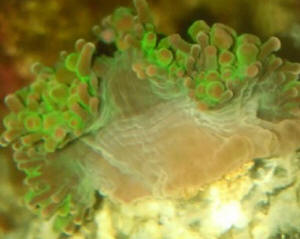
|
|
Good or Bad Hitchhiker? Usually Okay: Pseudocorynactis
spp. -- 8/3/10
Hello
<Hello Brenda, Lynn here today.>
I have sent 2 images of a "hitch hiker" that I cannot
identify.
<Pretty!>
A couple of these have appeared on live rock and I am praying
they are not some sort of bad anemone.
<No worries, they're definitely not anemones. What you
have is actually a type of Corallimorph (mushrooms, Ricordeas,
etc.) in the genus Pseudocorynactis, possibly Pseudocorynactis
caribbeorum, aka the Orange Ball Corallimorph. They're
commonly found in rock crevices and overhangs, and are mostly
nocturnal, opening at night to catch passing pods and
zooplankton. As for size, they can reportedly get fairly large,
but the norm in aquaria seems to be ~5cm/2 inches or less. Also
of note is that while these are carnivorous, since most are
nocturnal, the risk to fishes is slight. Even with
species/individuals that stay open during the day, fishes tend to
steer clear, just as they would an anemone.>
I have already killed an Aiptasia recently (it killed 4 Fungia
before I found it),
<Yikes!>
..but this does not look anything like the Aiptasia did,
however?
<Nope, although these do share certain physical similarities
with Aiptasia, they're entirely different animals.>
This critter is translucent with iridescent colours, long
tentacles with a colored pom-pom at the end, about 1.5" in
diameter, and has a central mouth. It has always been in this
position in the tank and has not moved. I have looked everywhere
to find an image that looks anything like this and have not been
able to find any information.
<There are some excellent photos at this link:
http://www.actiniaria.com/pseudocorynactis_caribbeorum.php
We also have more information/photos at WWM. Just Google
'Pseudocorynactis' here:
http://www.wetwebmedia.com/Googlesearch.htm >
Can you tell me what this might be, if it is something that can
harm corals or fish,
<The potential is there, yes, but in most cases, they're
innocuous.>
..and if I should get rid of it?
<I would leave it/them until or unless you experience a
problem; for example, one encroaches on a coral, or the
population explodes. If you should find one uncomfortably close
to a coral, try eliminating it just as you would Aiptasia. As for
overpopulation, that's not something that occurs all that
often but under the right circumstances, it's possible so
avoid over-feeding. All in all, these are beautiful little
additions to systems that are for the most part
inoffensive.>
Much appreciated,
<You're very welcome.>
Brenda
<Take care, Lynn Z>
|
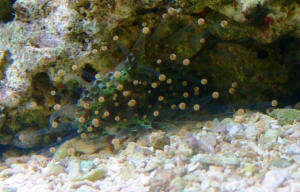 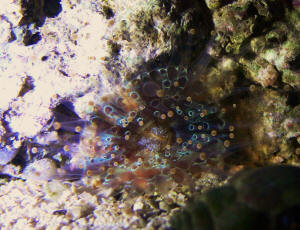 |
|
New mushroom ID please 7/27/10
Good Morning Crew!
<April>
Just a quick thank you for all that you do!! I read the dailies
every chance
I get (5-6 days a week) and have learned so much!
<Ah good>
On Saturday I went to my fish store to get salt mix and I saw
this mushroom and decided I wanted it. It has really cool
coloring. I don't think it is fully opened up yet only being
in the tank almost three days. There are small orangish
'tentacles' around the very outside edge of each
mushroom.
I hope you can tell from these pics. They are from my cell and
aren't the best. I can take some with the actual camera later
on if you need clearer ones.
<These pix are too poorly resolved (blurry) and small to tell
much>
One question too...the first day they were in the tank the higher
one had white stringy matter coming from it's mouth. I
thought maybe it was it's insides. It seems to have rectified
itself now though. Is that normal?
<Not usually, no. Can be indicative of health issues>
Again...thank you for all you do!!
April
<For identification and health input please read here:
http://wetwebmedia.com/corallim.htm
and the linked files above. Bob Fenner>
|
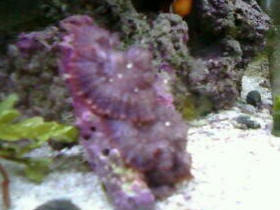 |
|
Anemone/ Mushroom? ID help 6/13/10
Hi,
<Saludo>
My name is Nigel and I am from the UK.
<I'm Bob from the States>
I have searched your excellent website and the internet hoping to
identify some animals that I have in my marine tank but alas am
still unsure, I am hoping that you may be able to help with
this.
<Some sort of Corallimorpharian>
I have kept tropical fish for over 25 years and have several
tanks scattered about the house ranging from 10 gallons up to 90
gallons, luckily I have a very understanding wife who also
appreciates the beauty of the hobby!
<A bonus>
About 7 years ago I was carrying out some work at a
customer's house and happened to mention my hobby, the
customer was also a fan of tropical fish having a small tropical
tank himself, he also had a 21 gallon marine tank
which he was looking at breaking down as it was located in his
cellar and he felt it was not getting the attention it deserved.
I had always been interested setting up a marine tank and I was
offered the opportunity to purchase the complete setup for a very
reasonable sum (a day's work!)
<One way of figuring/looking at such things>
At the time the tank contained plenty of live rock, 2 small
'Green Carpet Anemones' a few small metallic green
mushrooms and a few polyps.
<Mmm, these may well be some latter day starved out members of
the middle group>
7 years later, I have added a sump under the tank containing a
DSB, live rock and Caulerpa,
<Mmm, I'd remove this... dispose of properly. See WWM
re>
the main tank now is also home to a large leather/toadstool
mushroom,
<Oh, this Sarcophyton might well be (mal)affecting these
'Shrooms as well... chemical allelopathy>
10+ hermit crabs, hundreds of small bristle worms, thousands of
Amphipods and several feather duster worms and mussels
(hitchhikers).
<Neat!>
As I stated earlier when I bought the tank I was told that the
green animals were carpet anemones but I am not sure, could they
just be large mushrooms?
<Am pretty sure the latter>
7 years ago there were 2, I now have around 20 ranging in size
from 2 inches up to the largest which is 8 inches, they appear to
reproduce/ multiply by splitting and it is normally apparent that
this is going to happen when the mouth of the animal splits into
2.
<Typical for the group>
Some are attached to the rocks and others are in the sand bed
which is around 2.5inches deep.
They are fed twice a week on a frozen marine quintet (Artemia,
red plankton, squid, chopped cockle and chopped krill superb), I
places small pieces of these next to the mouths and they slowly
engulf the food.
The specific gravity is maintained at 1.0.23
<Mmm, one decimal point too many>
Temperature is 25 degrees Celsius
PH is 8.2
Lighting:
2 x T5 marine blue tubes on 10 hours daily
<I'd switch out these for whites...>
2 x Metal Halide bulbs 250W 14000K on 2 hours daily
<?! These are on a 21 gal. system? I must have gotten lost
here>
2 x LED Moonlights on throughout the night
Strong internal filters are positioned at either back corner of
the tank and the sump water is returned to the main tank via a
spray bar so water movement is good.
I was contemplating moving into the area of keeping marine fish
(only thinking of adding a couple of clownfish and maybe a Goby
initially) but like to think I have learnt my lesson and will
thoroughly research both fish and their requirements before going
ahead so I want to be 100% sure that my set up is suitable and in
particular am concerned of the reputation of carpet anemones for
eating fish!
<These should be fine here>
I have moved one of the animals to my sump to aid in taking the
pictures, this particular one has a diameter of approximately 4.5
inches.
Pic 1 is under 1 x T8 Marine blue light
Pics 2 and 3 are under 1 x T8 Power Glo white light
<Mmm, should work out>
I would be grateful for your help in identifying the animal on
the attached pictures and thank you for your time and brilliant
work on your website.
Nigel
<Thank you for sharing. Bob Fenner>
|
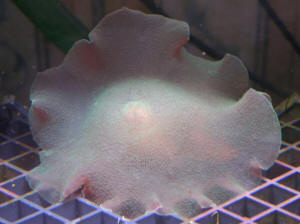 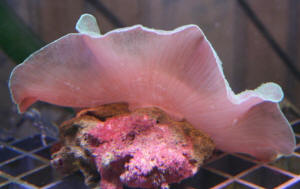 |
Just A Quick Question Re ID's
Please/Ricordea ID 6/12/10
Hello!
<Hello Richard>
Thank you again for your assistance with my information hunt, it's
proving very educational.
<You're welcome.>
I have come across information on how to tell Florida Ric's and
Yuma's apart, but am getting conflicting data. One method suggests
that the Florida Ric has raised polyps right up next to it's mouth
and the Yuma does not... the other suggests the exact opposite. Could
you confirm one or the other please?
<Richard, R. yuma tends to be more knobbier than R. florida and
shows only some minor variation in disk color while Ricordea Florida
comes in several color combinations such as orange, green, yellow,
blue, and purple with
some having blue, purple, or orange rings surrounding a contrasting
middle color. I hope this information helps you, and you may want to
peruse our Corallimorph ID FAQ's found here.
http://www.wetwebmedia.com/mushridf3.htm
James, Salty Dog>
Richard J.C.
|
Corallimorph ID 5/31/2010
Good day to whomever is assisting with this query, and thanks to
all of you for such an awesome, helpful site!
I am purchasing a lovely little mushroom from a friend, but I
have no idea what it is. It has been labeled Ric. florida, yuma,
plain ol mushroom,
<Mmm, not able to state definitively twixt R. floridae or R.
yuma w/o seeing the oral cone, but this is likely the latter.
I'd put the string:
"Identifying Ricordeas" in your search tool and read
re>
Corallimorph etc etc. (I know some of those categories are
overlapping!) So I just wanted to ask for a better verdict from
the experts... I believe the Yuma's are the rarer/more
expensive of the lot. Regardless of its pedigree I'm a fan of
this coral, but as a biologist I like knowing what's in my
tank!
Please refer to pics below, and thanks again!
Kind Regards,
Dane
<And you. Bob Fenner>
|
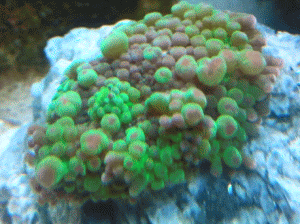  |
|
Re: Corallimorph ID, s/he said s/he
said nonsense. No thanks 6/1/10
Hey Bob,
<... Dane>
thanks very much for your input on this little creature. I also
followed it up at the same time with Gary Majchrzak on reef
central - he's one of the godfathers of mini carpet anemones
if I'm not mistaken. And he said he's 99% sure its an S.
tapetum anemone.
<... on what bases? Please... don't send opinions w/o
substantiation... This is not factual material of use. B>
I'm not trying to raise dispute, but wanted to add the input
for the sake of others and to get your feedback. I
will try send through a pic of the oral cone when I *eventually*
collect this one :-)
Thanks again very much for your assistance.
Kind Regards
Dane
|
|
|

